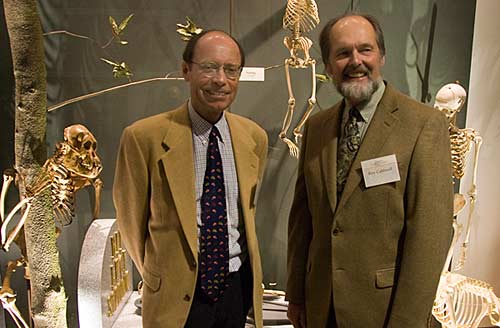 Hominid-excavator extraordinaire Tim White (left) and UCMP Director Roy Caldwell created the corridor display tracing humans' evolutionary history. (Jeffery Kahn photo)
Hominid-excavator extraordinaire Tim White (left) and UCMP Director Roy Caldwell created the corridor display tracing humans' evolutionary history. (Jeffery Kahn photo)Evolution exhibit honoring F. Clark Howell debuts in VLSB
'Skeletal tableau' of human ancestors is designed to educate and inspire visitors
 |
| 20 November 2008
BERKELEY — Within spitting distance of the assembled bones of a Tyrannosaurus rex, the skeletons of creatures who lived more recently have taken up residence in the Valley Life Sciences Building.
A new exhibit along the main second-floor corridor of the building features a skeletal tableau of our closest living relatives — a chimpanzee, an orangutan missing a few teeth, a pensive modern human, and a siamang — all contemplating a replica of the bones of our most famous ancestor, Lucy. The 3 million-year-old, child-size adult skeleton, unearthed in Ethiopia in 1974, lies in front of a tombstone reading "RIP, Lucy, 3,200,000 years."
The exhibit, jointly sponsored by the UC Museum of Paleontology (UCMP) and the Human Evolution Research Center, is the handiwork of integrative-biology professor Tim White and a slew of students and postdocs, who assembled the 46-foot-long display to trace the evolutionary history of humans and highlight Berkeley's contributions to that knowledge, specifically to the fields of paleoanthropology and paleobiology.
"Human evolutionary studies are more active on campus today and broader than they ever have been," White said.
White, for example, was on the team that examined the bones of Lucy and determined that "she" represented a new species of human ancestor. His Ethiopian expeditions over the past 27 years, which are summarized in an exhibit video, have discovered human ancestors from time periods stretching back nearly 6 million years.
White joined UCMP Director Roy Caldwell and other campus officials on Nov. 12 to dedicate the exhibit to the late F. Clark Howell, the dean of African paleoanthropologists, who died last year. Howell's wife, Betty, and son Brian were in attendance.
"The most critical element to me in doing the project was to honor the memory of Clark Howell for inspiring generations of Berkeley students and for his lasting impact on the field of paleoanthropology," White said. In 1970, Howell founded a laboratory that became the Human Evolution Research Center, which White now directs.
Caldwell credited White's energy, noting that "Tim was popping in and out of the ceiling" and squeezing into the tight, 3-foot-wide case to arrange the skeletons and displays. "There's no way I could have done that," Caldwell said.
One end of the exhibit is anchored by a camp table Howell might have used during his African explorations, strewn with notes, rocks, and fossils, including a crocodile skull. The table sits in front of an actual photo of Howell's 1973 camp in the Omo region of Ethiopia and is accompanied by a slide show describing Howell's legacy in addition to past and current Berkeley research in human evolution.
At the other end crouches a saber-toothed cat from the La Brea tar pits in Los Angeles, one of many skeletons dug up in 1912 by Berkeley paleontologists and now stored in the Campanile. Assembled by the Museum of Paleontology, the saber-toothed cat, Smilodon californicus, has one thing few other such fossil reconstructions have: its retractable claws. Though cats' claws, like fingernails, are not preserved along with fossil bones, White insisted on including these reconstructed claws on one paw, modeling them after those of living lions.
The remainder of the exhibit illustrates human evolution by means of the skeletal primate tableau, charts of human genealogy, a discussion of molecular evolution, and casts of hominid skulls excavated by White and his team.
The video and other supporting material will debut on a UCMP website early next year, thanks to the work of Berkeley post-doc Rebecca Jabbour, who acted as an "air traffic controller during the whole project," White said. Jabbour was supported by funds from the office of the vice chancellor for research.
White has already received ecstatic feedback on the exhibit. Before the official opening, a group of elementary-school kids came through VLSB and converged on the exhibit, enthusiastically chanting, "Lucy, Lucy."
"It's amazing what we can inspire by an exhibit like this," White said.

